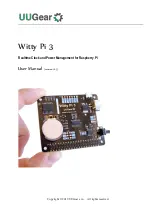
CAN-8123/CAN-8223/CAN-8423 user’s manual (Revision 3.00, May/22/2009) ------
144
EMCY Communication Example
Before starting the example, CAN-8423 with I-8057, I-8053, I-8024 and
I-87017 slot module are needed. Here, the same hardware configuration
shown in the PDO example is used for the EMCY communication.
Step 1. In order to generate the emergency event, it’s necessary to send the
data to RxPDO1 with data length 1.
11-bit COB-ID (bit)
Func Code
Node ID
8-byte Data (byte)
10 9 8 7 6 5 4 3 2 1 0
RTR
Data
Length
0
1
2
3 4 5 6 7
0 1 0 0 0 0 0 0 0 0 1
0
1
00 00 00
00
00 00 00
00
PDO
consumer
PDO producer
(CAN-8123/CAN-8223/
CAN-8423)
COB-ID
: 0x201
L
: 1
PDO-msg
: 00
Step 2. Then, the CAN-8423 will reply to an emergency message based on the
PDO data length of TxPDO1 doesn’t correspond to the value defined in the
PDO mapping object.
11-bit COB-ID (bit)
Func Code
Node ID
8-byte Data (byte)
10 9 8 7 6 5 4 3 2 1 0
RTR
Data
Length
0
1
2
3 4 5 6 7
0 0 0 1 0 0 0 0 0 0 1
0
8
10 82 11
09
00 00 00
00
EMCY
consumer
EMCY producer
(CAN-8123/CAN-8223/
CAN-8423)
COB-ID
: 0x81
EMCY-msg
: 10 82 11 09 00 00 00 00
The first two bytes “10 82” are for the emergency error codes. The
3rd byte “11” is for the error register, i.e. the CAN-8423 has either a
communication or a generic error. The last five bytes “09 00 00 00
00” are for the manufacturer specific errors. This emergency
message means that the data length of TxPDO doesn’t
correspond to the value defined in the PDO mapping object.
















































